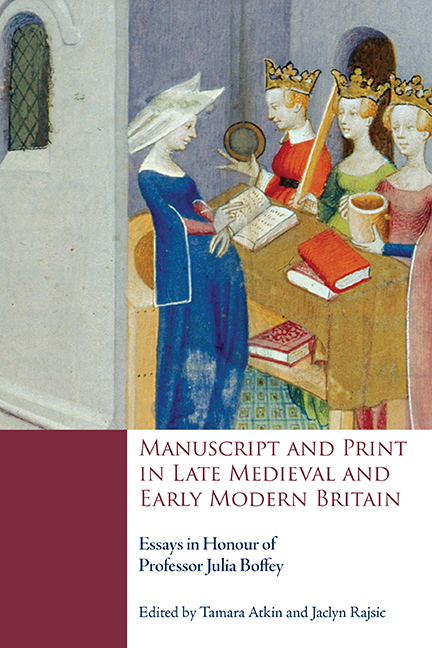 Manuscript and Print in Late Medieval and Early Modern Britain
Manuscript and Print in Late Medieval and Early Modern Britain Book contents
- Frontmatter
- Contents
- List of Illustrations
- List of Contributors
- Acknowledgements
- List of Abbreviations
- Introduction
- PRODUCING TEXTS
- 1 Gower's ‘Epistle to Archbishop Arundel’: The Evidence of Oxford, All Souls College, MS 98
- 2 From Oxford to Eton with Master John Maunshull: Teaching the Tria sunt in Bodleian Library MS Laud misc. 707
- 3 Gavin Douglas, Aesthetic Organization and Individual Distraction
- 4 Gavin Douglas's Eneados: The 1553 Edition and its Early Owners and Readers
- 5 Caxton and the Crown: The Evidence from the Exchequer of Receipt Reconsidered
- 6 Late Medieval Books of Hours and Their Early Tudor Readers In and Around London
- 7 London, British Library, MS Harley 367 and the Antiquarian Ideals of John Stow
- READING INFLUENCE
- Afterword
- Julia Boffey: A Bibliography
- Manuscript Index
- General Index
- Tabula Gratulatoria
6 - Late Medieval Books of Hours and Their Early Tudor Readers In and Around London
from PRODUCING TEXTS
Published online by Cambridge University Press: 06 September 2019
- Frontmatter
- Contents
- List of Illustrations
- List of Contributors
- Acknowledgements
- List of Abbreviations
- Introduction
- PRODUCING TEXTS
- 1 Gower's ‘Epistle to Archbishop Arundel’: The Evidence of Oxford, All Souls College, MS 98
- 2 From Oxford to Eton with Master John Maunshull: Teaching the Tria sunt in Bodleian Library MS Laud misc. 707
- 3 Gavin Douglas, Aesthetic Organization and Individual Distraction
- 4 Gavin Douglas's Eneados: The 1553 Edition and its Early Owners and Readers
- 5 Caxton and the Crown: The Evidence from the Exchequer of Receipt Reconsidered
- 6 Late Medieval Books of Hours and Their Early Tudor Readers In and Around London
- 7 London, British Library, MS Harley 367 and the Antiquarian Ideals of John Stow
- READING INFLUENCE
- Afterword
- Julia Boffey: A Bibliography
- Manuscript Index
- General Index
- Tabula Gratulatoria
Summary
THE BOOK THAT A LATE-MEDIEVAL or early-Tudor reader was most likely to possess was a book of hours. By the end of the fifteenth century this type of volume was widely available in England in a variety of forms designed to appeal to all tastes and pockets, ranging from de luxe manuscripts with fabulously illuminated borders and full-page miniatures to small printed horae with woodcut illustrations. Book of hours were used in private daily devotions and thus became very personal, highly valued possessions that their owners were likely to bequeath to near relatives or close friends; with other spiritual books they are the types of volumes most likely to be mentioned in wills of this period. The ownership and donation inscriptions that such exchanges generated, the memorialization of family members through the entry of their obits in the prefatory calendars, and the tendency to fill up blank leaves with records of the births of children, combine to make books of hours valuable sources of information about personal social networks. They are thus particularly rich resources of biographical detail about late-medieval and early modern readers and reading communities, yet tend to be treated rather reductively as sources of evidence about reading itself. They are assumed to be books that were only used in the practice of devotion, at home or in church, for the saying of daily prayers in imitation of monastic brethren, for the correct observance of fast days and festivals, for venerating local or personally favoured saints – in short, for fulfilling all manner of religious obligations. All of this activity, much of it literate, is somehow not factored as indicative of reading habits and practices. Books of hours are more typically cited merely as evidence of an owner's piety and wealth; in literary terms they tend to be regarded as ‘just’ books of hours and not something more interesting.
In fact, the contents of books of hours are more varied and copious than might be imagined. Certain differences in original content, such as in prescribed use (in England normally of Sarum or York), or in the provision of prayers to particular saints, may reveal information about the circumstances of the book's production and intended market, but these aspects, which are usually well-documented in catalogue entries for books of hours, are not the features that concern me here.
- Type
- Chapter
- Information
- Manuscript and Print in Late Medieval and Early Modern BritainEssays in Honour of Professor Julia Boffey, pp. 107 - 122Publisher: Boydell & BrewerPrint publication year: 2019
